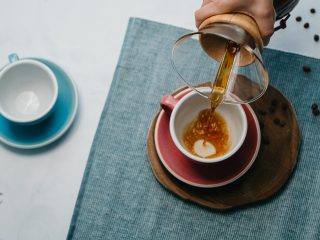Infusing coffee with flavors has been a hot topic for some time, generating a lot of discussion in the industry and dividing the coffee community into supporters and opponents of the process. We have collected the opinions of many industry experts who roast and sell coffee in various countries and we come to the rescue with a solid portion of knowledge. Feel free to read and draw your own conclusions, I hope you will be able to form your own opinion about infused coffees based on the information below!
Traditionally, coffee is processed in one of three ways: wet, dry and ‘honey’, which is in-between. You can read more about it in the article by Maciek Duszak. In recent years, however, the experimental methods have become visibly more popular. In the Barista World Championships, the competitors do their utmost to surprise the sensory judges. One way to do that is through coffees processed with innovative methods. Coffee producers have reached for the fermentation techniques long known in the winemaking. This method was pioneered by Sasa Sestic, the 2015 WBC winner, whose adventure with fermentation is extensively described in the Perfect Daily Grind article. Fermentation has changed the trajectory of coffee production and also made it possible to add other flavors to coffee. The door has opened for both very good and very bad coffee.
The rules of the World Coffee Championship state that the competitor must not use coffee to which any additives, aromas, dyes, perfumes or fragrances were added between harvesting and extraction, so we are safe here. Probably. Competitors must obtain this information from farmers and verify it to ensure that they are not disqualified, but sometimes, completely unknowingly, they get false information.
The competitors were sure that their lots were 100% not infused. However, I believe that without infusion, they couldn’t have had such a strong cinnamon profile. Hints of cinnamon and rose may appear in coffee, but at such intensity they are highly unlikely to be natural, says Sasa Sestic in the above-mentioned PDG article.
Unskillful fermentation and flavoring make the coffee taste artificial and lose its natural and desirable flavor. Professional execution of these processes can bring about very good taste, but concealing flavoring will result in the loss of trust. Therefore, as far as the infused coffee goes, the coffee community is concerned about two issues: quality and transparency.
Piotr Jeżewski, Co-founder & Roaster, Heresy Coffee, Vice-champion of Polish Roasting 2020:
Let’s start with an anecdote. In mid-2020, Polish roaster gave me beans from a Colombian producer known for experimenting with fermentation. Surprisingly, the coffee smelled exactly the same at all stages of the evaluation: whole beans, ground beans, brewed beans, and even… cold coffee grounds. The same intense, artificial-fruity aroma. And in taste – the smell! In October 2021, I took the package out of the cupboard – the coffee may have perhaps lost somewhat of its intensity. It tasted a bit dirtier and more empty in cupping, but that exaggerated, candy-like apricot flavor was still the dominant feature. More than a year since roasting! I don’t mind ‘pumped up’ coffee as such. We could have anticipated this trend already a few years back in connection with the ‘scandal’ of adding cinnamon to Costa Rican anaerobic coffees or the entry of commercial yeast for coffee fermentation into the market. These, in a nutshell, are designed to modulate the final profile in order to improve the quality and ‘raise’ the points of, mostly, beans from the so-called lower specialty (say, 80-84 SCA scoring). No wonder that manufacturers are taking the next step and trying by all means to stand out on the international scene, making their product more attractive.
I am opposed to the notorious lack of transparency of producers, importers and roasters. It’s a chain reaction where the manufacturer (and sometimes, perhaps, the importer) keeps to himself the details of the process that made an ‘ordinary’ castillo grown at 1,400 meters smell and taste like three bubble gums and a spoonful of sugar all at once. Instead, the label reads the laconic ‘anaerobic experimental process’. And the price is three times higher. Such coffees, placed on the table next to coffees processed ‘naturally’, dominate them with intensity or level of sweetness. As a rule, it is easier to capture specific, evident flavor notes in such brews. But it’s like juxtaposing the highest quality Taiwanese oolong with its subtle floral and fruity notes with aromatized Herbapol tea. I am also amazed at the high susceptibility of many coffee professionals to these practices, dubious from the point of view of transparency. How many times have I heard: ‘No, it’s all definitely natural!’… It’s hard for me to understand that after tasting hundreds or thousands of coffees over the years red lights so rarely go on at tables with ‘fake-fermentations’ 😉
As for the story with ‘apricot’ coffee – it is not even a matter of covering up the fact that supposedly the fruit was added to the beans during processing. At such intensity and ‘miraculous’ retention in the roasted grain, I put a bag of 90 score Geisha that an artificial flavor was used there. As is the case of so many other foods. It is definitely a serious ethical problem. More money for producers – yes! But not like this. In my opinion, we need an arbitrary, well-thought-out and universal system that will clearly distinguish coffees processed with external enhancers.
The fact of producing these coffees is definitely not a problem. On many markets around the world, coffee flavored with cinnamon sticks or essential oils will become popular and will find their fans. This is especially valuable in view of climate change and the likelihood of a low supply of high-quality coffee in the future. The problem is transparency.

Wojtek Białczak, Head Roaster, Five Elephant, Vice-champion of Polish Barista 2021:
I believe that everything is for the people. Facing the possibility of insufficient amount of coffee in the future, it seems positive that the new processes, once they are improved, can boost the quality of slightly inferior coffees, which will have a better chance of surviving the inevitable climate change. There is no doubt that high-quality coffees require a suitable climate, the demand is growing and the climate is not improving. At the moment, the flavored coffees are far from ideal, because they taste artificial. On top of all this, there is a problem with nomenclature – so far, flavoring has been hidden under the name of ‘anaerobic’ fermentation or similar. The lack of transparency in the specialty industry is unacceptable in my opinion.

When everything is transparent, flavoring can go very well. At World of Coffee in Dubai, London-based Assembly Coffee presented the Fruit Fermentation Series – three coffees with fruit aromas: strawberry, orange and passion fruit. During the natural treatment process, the coffee cherries were dried with fruit. Customers were informed about it by labels and additional information on the coffees, and Assembly employees explained the process to all interested parties at the stand. I must say that they tasted delicious, during the whole festival I drank coffee mainly at that stand!
Nick Mabey, Director of Assembly Coffee, UK:
Infused coffees have been under the spotlight for a while, causing many to seek a greater understanding of the definitions and boundaries between coffee genetics, processing, transparency and value creation for producers and consumers alike. I have been seeking to improve all elements of my understanding of where the division between value creation and value extraction intersect for all stakeholders and now understand that the real need for reform on this topic actually begins with a fundamental re-education of the industry on the real function of fermentation across washed and natural coffees as it pertains to traditional processing first and foremost. Only then can we understand the limits and possibilities of exotic and experimental processes and the markets they create. The recent Pink Bourbon Fruit Infusion coffees brought by Felipe Arcila at Cofinet are quite simply conversation stoppers. Their absolute integration of genetics, processing and infusions have created coffees that quite simply speak for themselves and have taken years of innovation and experimentation to perfect. They should be celebrated on this merit alone. It should be noted that most infusions on the market simply aren’t very good which is why even the most purest of coffee lovers have been converted on tasting these specific results.
So, is it good or bad? The answer is, in the words of my high school physics teacher: it depends. Mainly on the manufacturer, his diligence, knowledge of the process, and, above all, honesty. Fermentation can bring remarkable results, while the artificial flavoring of specialty coffees is a departure from the principles we have adopted as the industry.
Mateusz Tryjanowski, Head of Marketing & E-commerce, B2C Sales
In general, when it comes to infusing coffees in the broad sense, we stick to a simple assumption – you can do anything as long as you are transparent and straightforward about the ‘what, where and why’ of it! Of course, there is one essential ‘but’…. the key is whether you interfere before or after roasting.
We reject the second option at the very beginning – it’s a shortcut, not fitting for the specialty segment. If you are trying to change the taste of a practically finished product in a specific, easiest and cheapest way, then you are not playing fair.
In our opinion, only the first option – that is, actually, additional processing of the green bean – is fair. Assuming that the consumer is fully informed about what happened to a given coffee, we treat controlled fermentation (using a dedicated yeast strain or bacterial culture), the so-called fake fermentation (fermentation of coffee tree cherries with the addition of, for example, other fruits) and barrel aging as equal. Whether the treatment is on the farmer’s side or the roaster’s side doesn’t matter that much.
More important than ‘where’ is ‘why’ – e.g. we do not throw past crops and other weak beans into barrels to hide their flaws, but we throw in coffees that already taste good so as to enhance their specific notes or add complexity. We always try to launch the barrel aged version together with or shortly after the launch of ‘regular’ coffee, for full comparison. On the one hand, we (and our customers!) like those barrel notes, oaky vanilla and liqueur finish – on the other hand, it is convenient to have these ‘2 in 1’, check what such an experimental process has added, and then have a choice: mild standard vs. pumped up version.
Honestly, we think this is the future of coffee – customers are looking for ever stronger experiences and more intense flavors. You can see this not only on the example of BA coffees – for the ‘wow effect’ a simple washed Geisha is not enough, you need to have the extended-fermentation-blah-blah version, preferably endorsed with a well-known name (e.g. Diego Samuel Bermudez), with guaranteed surprise. Customers don’t always want to look for subtle nuances and refine the recipe twenty times to finally get them all – they want spectacular results without great effort. They need coffee that will always be good and not coffee that requires great precision.
It is important that there is a clear line between what can be done without additional processing – and what cannot – so as not to expect an equally spectacular flavor profile from a delicate, washed coffee!

Michał Sowiński, Head Roaster, Fjord Coffee
I must admit that the topic of infused coffee has been bothering me for a long time. And I am not talking about flavoring commercial coffee, which has been popular for years, because this segment is not exactly my thing. I am thinking more about what is currently happening on the specialty market, under the guise of innovative methods of processing or fermentation.
I remember that when I tried infused coffee for the first time, the impression was initially very positive. Finally I was given a cup which exceeded with its intensity the limits I had previously known. After some time, however, I began to notice that flavoring is a procedure often aimed at covering medium-quality, one-dimensional coffees and increasing their intensity. And while it would not bother me if it was transparent, I feel much offended when I am deceived (unfortunately, this is how I need to call it) that this intensity comes from elaborate anaerobic fermentations and even laboratory experiments on plantations. Especially, since it is sold to coffee beginners. If their reference point for expectations about the intensity of given aromas or flavors is built on a lie, then trying the classically processed coffee, even of exceptional quality but devoid of artificial intensity, they will not be entirely satisfied, recalling memories of that ‘fruity’ coffee they had been drinking. These aromas are often not natural. I think that we should learn our lesson from the beer industry and stop being ashamed to say out loud that something was added on some stage of production. I’m sure it would better serve educating clients and building honest and transparent coffee businesses.

Let’s finish with a short sentence that here, in Coffeedesk we repeat like a mantra – the best coffee is the one that tastes the best. We will continue to defend transparency, first and foremost, and then freedom of choice. Artificial flavoring is a departure from the canon of specialty and we stand by clear designations. But if you feel like having a flavored coffee – there’s nothing wrong with that.












